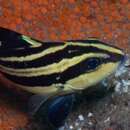fi
nimet breadcrumb-navigoinnissa


Die Seilvin-rubberlip (Diagramma centurio) is 'n vis wat voorkom in die westelike Indiese Oseaan vanaf Kenia tot by Durban, en benewens om Madagaskar, die Comore-eilande en Seychelle.
Die vis is silwergrys met verskeie bruin of swart spikkels aan die bokant van die lyf. Die dorsale vin is baie lank. Die vis word 1 m lank. Die onvolwasse vissies is grys of geel met 'n breë band oor die middellangs oor die lyf, van die kop tot aan die stertvin. Soos die vissie groei word die donker bane meer en as die vis langer as 20 cm raak breek die bane op as kolletjies.
Die vis kom voor by koraalriwwe in water van 3 – 50 m diep. Die onvolwasse visse hou in seegrasbeddings. Dit is 'n goeie tafelvis.
Die Seilvin-rubberlip (Diagramma centurio) is 'n vis wat voorkom in die westelike Indiese Oseaan vanaf Kenia tot by Durban, en benewens om Madagaskar, die Comore-eilande en Seychelle.
Diagramma centurio és una espècie de peix pertanyent a la família dels hemúlids.
És un peix marí, associat als esculls i de clima tropical que viu entre 3 i 50 m de fondària.[4][6]
Es troba a l'Índic occidental: des de Kenya fins a Durban, les illes Comores, Madagascar i les Seychelles.[4]
La seua carn és de qualitat excel·lent.[6]
És inofensiu per als humans.[4]
The sailfin rubberlip (Diagramma centurio) is a species of marine ray-finned fish, a sweetlips belonging to the family Haemulidae. It is found in the western Indian Ocean.
The sailfin rubberlip has adults and subadults which are overall silvery grey, although they may be marked with many dark brown or black dots on head and back when they are over 30 to 100 cm (12 to 39 in) in length. Smaller subadults have slightly larger orange-brown spots scattered on the upper part of the head, body and caudal peduncle. The juveniles at a length of approximately 12 cm (4.7 in) may be grey or yellow, with a wide black band running from the snout through the eye to the rear margin of the caudal fin, another runs from top of head to posterior margin of the dorsal fin. There is an arcing black band from the front of the dorsal fin covering the lower 2/3rd Of the fin. There are black margins on the pelvic and anal fins, the corners of caudal fin. There are additional stripes which as the fish grows and once they have attained a length of around 20 cm (7.9 in) the stripes start to fragment into spots. The dorsal fin contains 9-10 spines with the front spines lengthened in smaller juveniles while in adults the 2nd and 3rd spines are the longest, and 21-25 soft rays. The anal fin contains 7 soft rays. This species attains a maximum total length of 100 cm (39 in).[3]
The sailfin rubberlip is endemic to the western Indian Ocean. It occurs along the African coast from Kenya to South Africa, in Madagascar, the Comoros Islands and the Seychelles.[1]
The sailfin rubberlip is found at depths between 3 and 50 m (9.8 and 164.0 ft) on coral reefs. The adults tend to be solitary or to live in small aggregations but the juveniles live within beds of sea grass.[1] This is a predatory species which has a diet dominated by crustaceans and small fish.[4]
The sailfin rubberlip was first formally described in 1830 by the French zoologist George's Cuvier with the type locality given as the Seychelles.[2] Some authorities place this species in the genus Plectorhinchus,[5] while others regard the genus Diagramma as a synonym of Plectorhinchus.[6] The specific name “centurio” is derived from “centurion”, the Roman legionary officer, a reference to the local French colonial name of capitaine in the Seychelles.[7]
The sailfin rubberlip is caught using caught using hand lines and it is thought of as a quality food fish.[1] It is also caught using spears. This large species is not suitable for most home aquaria but it is displayed in some public aquariums.[4]
The sailfin rubberlip (Diagramma centurio) is a species of marine ray-finned fish, a sweetlips belonging to the family Haemulidae. It is found in the western Indian Ocean.
Diagramma centurio Diagramma generoko animalia da. Arrainen barruko Haemulidae familian sailkatzen da.
Diagramma centurio Diagramma generoko animalia da. Arrainen barruko Haemulidae familian sailkatzen da.
Diagramma centurio is een straalvinnige vissensoort uit de familie van de grombaarzen (Haemulidae).[1] De wetenschappelijke naam van de soort is voor het eerst geldig gepubliceerd in 1830 door Cuvier.
Bronnen, noten en/of referenties